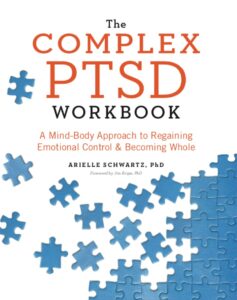Quite regularly I receive inquiries from clinicians and prospective clients asking me if it is appropriate to use EMDR Therapy for complex PTSD and childhood trauma. My short answer is yes, EMDR Therapy is an incredibly valuable therapeutic for treating C-PTSD; however, this powerful modality typically requires careful modification to attend to dysregulated and dissociative symptoms that often accompany early developmental abuse or neglect.
EMDR Therapy is an 8-phase treatment modality that systematically allows clients to process traumatic material and resolve lingering emotional, mental, and somatic distress. This post describes some of the most common modifications as related to the 8-phases that allow clients and clinicians to work together safely using EMDR Therapy for complex PSTD.
“Chronic, early developmental trauma memories are often preverbal and tend to be accompanied with dissociative symptoms. Therapists must emphasize the importance of resource development and careful pacing of EMDR Therapy so that clients feel safe in the present moment. You achieve successful treatment outcomes when you slowly build tolerance for the emotions and body sensations that accompany traumatic memories. The once overwhelming symptoms of C-PTSD can resolve as the client learns to turn toward pain and suffering with greater awareness and compassion.”
-Dr. Arielle Schwartz
Complex PTSD occurs as a result of long-term exposure to unrelenting stressors, repeated traumatic events, or attachment injuries that occur during childhood. Most often the trauma is interpersonal. An individual might have experienced chronic neglect, abuse, or exposure to domestic violence. It is also important to keep in mind that chronic trauma can also come from ongoing experiences of being bullied without protection, having an undiagnosed or unsupported disability, or being discriminated against without an advocate. In all forms of C-PTSD, the injury is repetitive, prolonged, and cumulative. Often the trauma occurs during vulnerable times of development such as in early childhood or during adolescence. These early experiences tend to shape the clients’ identity. (You can learn more about Complex PTSD here.)
The goal of EMDR Therapy for complex PTSD is to help clients develop an embodied Self that can compassionately hold their emotions, vulnerable sensations, and young parts in a safe way. The process requires that therapists understand how to work with preverbal or nonverbal memories by integrating a somatic approach because our earliest memories are stored as motor patterns, sensations, affective states, and psychophysiological arousal. Furthermore, given the interpersonal nature of the injuries, it is essential to focus on the relational exchange.
Let’s take a closer look at this approach to working with C-PTSD and attachment trauma across the 8-phases of EMDR Therapy:
It is important to help clients develop awareness of the parts that hold memories of early trauma. Sometimes, a part can have resistance to doing trauma work and can try to sabotage the therapy work. Other times, a part of self is holding the childhood traumatic memories. In EMDR Therapy we resource vulnerable parts with allies to create safety. Resourcing parts can take time; however, when a client has the correct resources, processing traumatic memories can be much gentler and more effective.
As with all EMDR Therapy, it is important to know that the process is not linear. This is especially true for early developmental trauma as the process is often slow moving and requires ongoing stabilization and resource development. A successful treatment outcome requires that you build tolerance for the emotions and body sensations that accompany traumatic memories. The client becomes increasingly able to access a Wise and Whole Self who is able to mindfully attend to the needs of parts while upholding the responsibilities of the adult in the world. The once overwhelming symptoms of C-PTSD can resolve as you learn to turn toward the parts of self that hold pain and suffering with greater awareness and compassion.

Connect to this post? The Complex PTSD Workbook, is now available on Amazon! Click here to check it out and increase your toolbox for healing. Whether you are a client or a therapist this book will offer a guided approach to trauma recovery.
Dr. Arielle Schwartz is a licensed clinical psychologist, wife, and mother in Boulder, CO. She offers trainings for therapists, maintains a private practice, and has passions for the outdoors, yoga, and writing. Dr. Schwartz is the author of The Complex PTSD Workbook: A Mind-Body Approach to Regaining Emotional Control and Becoming Whole. She is the developer of Resilience-Informed Therapy which applies research on trauma recovery to form a strength-based, trauma treatment model that includes Eye Movement Desensitization and Reprocessing (EMDR), somatic (body-centered) psychology and time-tested relational psychotherapy. Like Dr. Arielle Schwartz on Facebook, follow her on Linkedin and sign up for email updates to stay up to date with all her posts.

Arielle Schwartz, PhD, is a psychologist, internationally sought-out teacher, yoga instructor, and leading voice in the healing of PTSD and complex trauma. She is the author of five books, including The Complex PTSD Workbook, EMDR Therapy and Somatic Psychology, and The Post Traumatic Growth Guidebook.
Dr. Schwartz is an accomplished teacher who guides therapists in the application of EMDR, somatic psychology, parts work therapy, and mindfulness-based interventions for the treatment of trauma and complex PTSD. She guides you through a personal journey of healing in her Sounds True audio program, Trauma Recovery.
She has a depth of understanding, passion, kindness, compassion, joy, and a succinct way of speaking about very complex topics. She is the founder of the Center for Resilience Informed Therapy in Boulder, Colorado where she maintains a private practice providing psychotherapy, supervision, and consultation. Dr. Schwartz believes that that the journey of trauma recovery is an awakening of the spiritual heart.